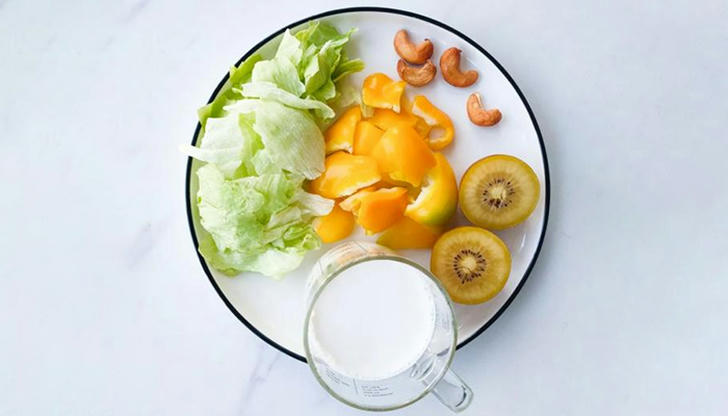5 Delicious Fruit and Vegetable Juices Designed for Those Who Dislike Eat Vegetables
Do you want to reap the health benefits of eating vegetables but are put off by the grassy odor of greens? Then you might want to try fruit and vegetable juices. By blending fruits and vegetables into juice, the fruity flavors can mask the tastes you dislike, helping you to enjoy the sweetness while also consuming a significant amount of vegetables.
We have considered color, texture, and sweetness, experimented with different recipes, and selected the five best-tasting fruit and vegetable juice recipes, perfect for those who do not enjoy eating vegetables.
Following the recipe, each serving will yield about 600 ml. You can consume 300 ml before your main meal and another 300 ml afterward. If you find the quantity too large, you can proportionally reduce the amount of all ingredients.
Recipe 1: Kiwi Flavor, 240 Calories

100 g yellow bell pepper: 26 calories
50 g romaine lettuce: 6 calories
100 g peeled kiwi fruit: 61 calories
250 ml skim milk: 85 calories
10 g cashews: 61.5 calories
With the tangy and sweet taste of kiwi, you might not even realize that bell pepper has been added if it's not mentioned. Both yellow bell pepper and kiwi are rich in Vitamin C, with a combined content of 166 mg of Vitamin C. The daily recommended intake for Vitamin C is 100 mg, so even if some nutrients are lost during juicing, it's not a concern. Pair this juice with two slices of bread and an egg for a nutritious breakfast.
Recipe 2: Pear Flavor, 311 Calories

100 g purple cabbage: 25 calories
50 g carrots: 16 calories
100 g pear: 51 calories
250 ml original soy milk: 163 calories
10 g walnuts: 56 calories
This recipe results in a juice that prominently features the taste of original soy milk, with the flavor of purple cabbage being undetectable. It's great news for those who dislike the taste of purple cabbage. Purple cabbage is rich in anthocyanins, and carrots are rich in beta-carotene, both of which have antioxidant effects. Walnuts are also a good source of alpha-linolenic acid, an essential fatty acid that is less commonly consumed through regular cooking oils. Pairing this with 50-75 grams of pure oatmeal and an egg makes for a nutritionally balanced breakfast.
Recipe 3: Yogurt Flavor, 252 Calories

100 g celery: 17 calories
50 g cucumber: 8 calories
100 g cantaloupe: 34 calories
40 g avocado: 68 calories
200 g sugar-free yogurt: 125 calories
75 ml cold water
The tangy flavor of the sugar-free yogurt overshadows the sweetness of the cantaloupe, resulting in a slightly sour taste with a hint of cucumber. The flavor of celery is mostly masked. Avocado is rich in monounsaturated fats, similar to those found in olive oil, which are beneficial for heart health to replace some saturated fats in your diet. If you don't often cook with olive oil, incorporating avocado into your diet can be a good alternative. Pair this juice with 200 grams of steamed pumpkin and 50 grams of ready-to-eat chicken breast for a meal that can be served as either breakfast or dinner.
Recipe 4: Watermelon Flavor, 286 kcal

100 g tomato: 15 kcal
50 g red bell pepper: 13 kcal
100 g watermelon: 31 kcal
15 g chia seeds: 64 kcal
250 ml original soy milk: 163 kcal
The juice from this recipe is not red, but pink, which looks very appetizing. The sweetness of the watermelon and the aroma of the soy milk stand out, while the flavors of the tomato and bell pepper are not noticeable. Tomatoes, red bell peppers, and watermelon are all rich in the antioxidant lycopene, and chia seeds, like walnuts, are also rich in the essential fatty acid alpha-linolenic acid required by the human body.
Recipe 5: Refreshing Taste, 274 kcal

100 g blanched broccoli: 27 kcal
50 g lettuce: 6 kcal
100 ml coconut water: 20 kcal
250 ml whole milk: 163 kcal
10 g almond nuts: 58 kcal
The color of this juice is not as green as broccoli. Thanks to the coconut water and milk, it has a refreshing and sweet taste, along with the nutty aroma of almond nuts. Broccoli has a high content of vitamin C among vegetables, with 56 mg/100 g. After blanching in boiling water for 1 minute and then straining for juicing, the bitterness of broccoli can be reduced.
